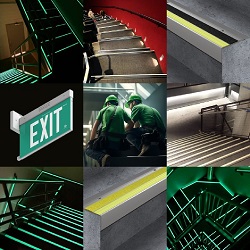









"Safety should never be compromised for the sake of convenience or aesthetics. Your facility's accessibility is of utmost importance."
Ensuring safe accessibility during peak traffic volumes presents unique indoor environment challenges. As per the Accessibility for Ontarians with Disabilities Act and the National Building Code of Canada, facility managers bear the onus to furnish consistent hazard detection and guidance cues mitigating potential trip and fall risks. Let's explore proactive risk minimization strategies leveraging code-certified solutions tailored for heavily used indoor locales.
Certain areas like concourses, food courts, and transit hubs witness phenomenal indoor pedestrian densities daily. Under such conditions, trip and fall accidents tend to escalate owing to:
• Obstructed visibility amid jampacked foot traffic impeding hazard identification.
• Worn-out or damaged flooring going unnoticed under relentless pounding.
• Distracted walking while multi-tasking, like eating/texting, increases contact mishaps.
National codes strictly mandate mitigating tripping risks through permanent TWSI installations. Some options tailored for intensive usage include:
• Surface applied or cast-in-place Ecoglo stair nosings along full stair tread edges - As mandated by NBC clearly demarcate risky zones even in zero visibility conditions.
• Advantage cast metal domes - Durable, slip-resistant warning for level changes as per CSA B651. These Cast metal plates withstand millions of footfalls without fading in subway stations and concourses.
• Access Tile replaceable polymer tiles at floor junctions or elevator entrances - Reliably guides mobility aid users per AODA and ISO 23599. AccessTile endure 10-15 years of pounding before targeted replacement in busy zones.
• Armor Tile paver systems for marking recessed walkway edges - Durable guidance in busy areas, according to OBC.
• Eon Tile rubber guidance indicators along main circulation paths - Flexible, chemical-proof navigation aids meeting international codes. These tiles absorb shocks and resist abrasions, suiting dynamic indoor passenger flows.
• Elan porcelain tactile indicators for interior designer applications - Slip-proof directional markers enhancing aesthetics as per ISO. It also lends aesthetics that match transit plazas while cementing integrity against scruffs.
Strategic TWSI positioning aids early detection before contact:
• Grid patterned domes at 10m intervals upon entering areas prone to jostling.
• Wayfinding ribs in waiting concourses aid orientation when vision impaired among swarms.
• Detection cues mark pinch-points prone to bottlenecking, like turnstiles every 3m for advisory alertness.
• Intermittent ribbing along lengthy routes prevents distraction induced veering off accessible paths.
In convention centers, retail malls, and similar crowded environments, additional accessibility precautions are warranted. Some smart strategies include:
• Spacing indicators closer (max. 2-3 feet) - Allowing quick identification even during shoulder-to-shoulder movement as per NFPA standards.
• Installing robust durable Armor Tile systems - Withstanding heavy footfall with a low risk of surface wear, as proven through ASTM testing methods.
• Selecting metal Advantage domes/bars - Durably handling intensive use without potential breakage issues as suggested by CSA standards.
• Implementing photoluminescent signs - Guiding foot traffic flows to prevent bottlenecks or blockages as per ISO standards protocols.
• Deploying crowd control signage/barricades - Safely partitioning high density spaces according to life safety codes for unhindered navigation.
• Training staff on tripping hazard mitigation - Achieving extra eyes on the ground to promptly address issues as recommended by OSHA guidelines.
Regular deep cleans restore textures critical for navigation underfoot:
• Schedule quarterly deep scrubs removing accumulations obscuring cues amid traffic congestion.
• Use non-abrasive detergents to gently wipe away debris compromise without degrading material properties.
• Inspect bond integrity post-cleaning, repairing de-bonded sections promptly to maintain slip resistance.
SWEEP inspections detect potential issues before contact occurs:
• S - Scrutinize high usage zones weekly; others bi-weekly
• W - Wear assessment for replacement considering 5-7 years in busiest locales
• E - Examine bond strength through Gentle probing of edges annually
• E - Evaluate visual clarity from all angles; replace faded/damaged units promptly
• P - Perform proactive maintenance factoring seasonal variations; address urgencies immediately
Together, the above techniques keep the TWSI network optimally functional for safe navigation underfoot, complemented by:
• Installing movable crowd control barriers amid escalating indoor pedestrian volumes.
• Temporary evacuation plans factoring facility shutdowns due to unforeseen maintenance or planned events.
• Conduct table-top emergency response drills to assess communication effectiveness annually.
In summary, the above multi-pronged approach centered on careful product selection, strategic placements, routine deep cleans, preventative inspections, and calibrated response drills empowers facilities to reliably safeguard indoor accessibility consistently. Leveraging expertise from accessibility solution partners like Tactile Solution Canada streamlines hazard minimization customized to unique building operational needs.
Our code-certified, rigorously tested solutions facilitate unhindered circulation optimized for safety. Don't hesitate to consult our indoor & outdoor accessibility advisors for aid in the selection, installation, or maintenance of TWSI networks essential for keeping busy indoor locales optimally navigable for all patrons.
